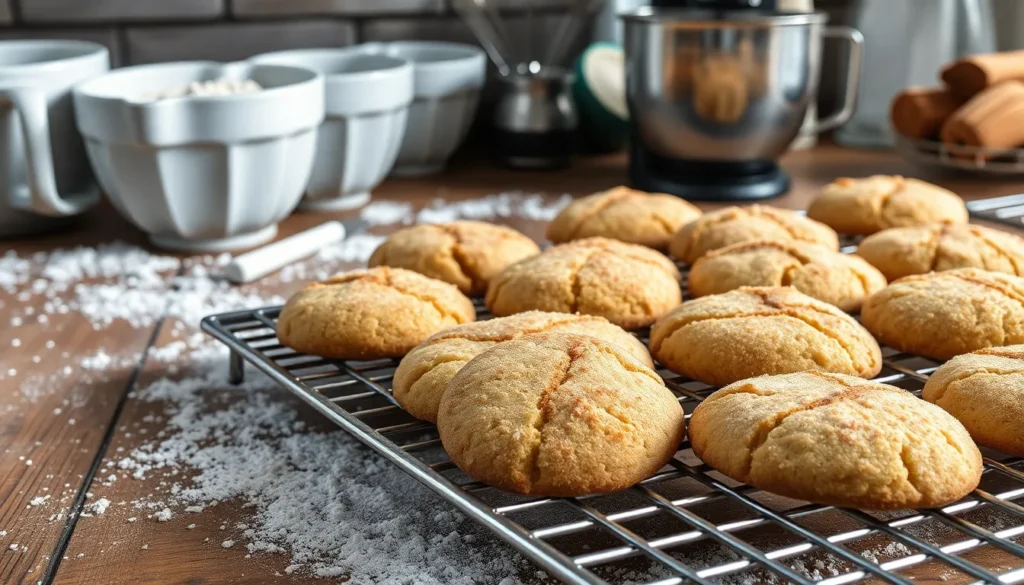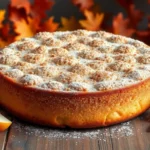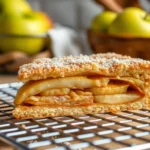We’ve all been there – craving those perfectly chewy, cinnamon-sugar-coated snickerdoodles only to discover we’re fresh out of cream of tartar. Don’t let that missing ingredient stop you from baking these beloved cookies! Our foolproof snickerdoodle recipe delivers all the classic flavors and textures you love without requiring a single pinch of cream of tartar.
These cookies boast that signature tangy bite and tender crumb that makes snickerdoodles irresistible. We’ve mastered the perfect substitute technique that creates the same delightful results – soft centers with slightly crispy edges, all wrapped in that iconic cinnamon-sugar coating.
Whether you’re a seasoned baker or just starting your cookie journey, this simplified approach means you can whip up a batch anytime the craving strikes. No special trips to the store required – just grab your basic baking staples and let’s create some magic in the kitchen.
What Makes These Snickerdoodles Special
Our snickerdoodles deliver all the beloved characteristics of traditional versions without requiring cream of tartar. We achieve that signature tangy flavor through a carefully tested combination of baking soda and vinegar that creates the same chemical reaction. This substitution produces cookies with an identical tender crumb and subtle tang that snickerdoodle lovers expect.
The texture remains perfectly soft and chewy thanks to our precise ratio of butter to sugar. We use a combination of granulated and brown sugar to create cookies that stay tender long after baking. Our method ensures each cookie develops those coveted crackled tops while maintaining a pillowy interior.
These cookies shine with their generous cinnamon sugar coating that clings beautifully to the dough. We roll each portion twice in the spiced mixture to guarantee maximum flavor coverage. The result is a cookie that tastes deeply of cinnamon with sweet crystallized edges.
Our recipe simplifies the baking process by using common pantry ingredients. We eliminate the need for specialty items while maintaining authentic flavor profiles. This approach makes homemade snickerdoodles accessible to any baker regardless of their ingredient inventory.
The dough comes together quickly without requiring chilling time. We designed this recipe for immediate baking satisfaction when cookie cravings strike. Our streamlined method produces consistent results every single time.
Ingredients
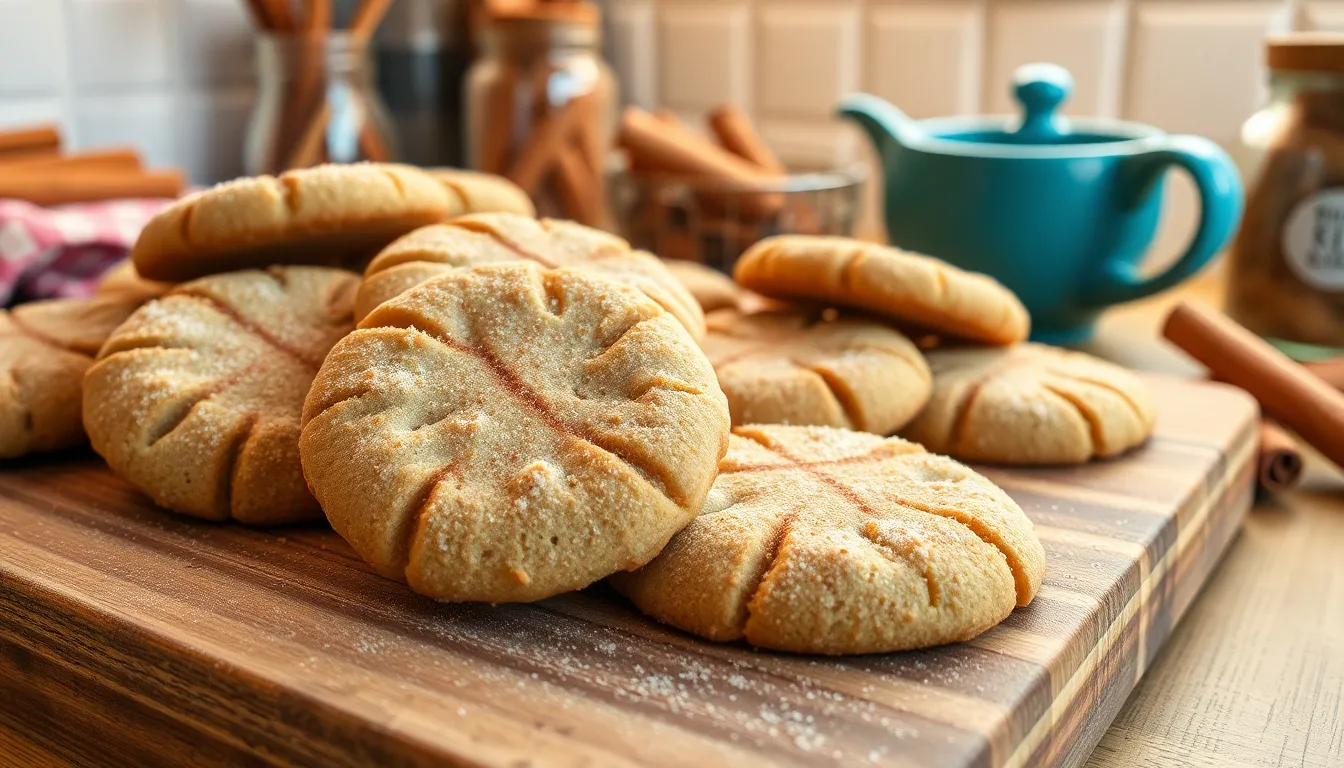
Creating these delightful snickerdoodles requires simple pantry staples that work together to deliver the perfect texture and flavor. We’ve organized our ingredients into two categories to streamline your baking process.
For the Cookie Dough
- 2⅓ cups all-purpose flour (about 298g) – provides structure and the perfect chewy base
- 1 teaspoon baking powder – our key leavening agent that replaces cream of tartar
- 1 teaspoon salt – enhances all flavors and balances sweetness
- 1 cup unsalted butter (227g), softened to room temperature – creates tender, rich cookies
- 1½ cups granulated sugar (up to 298g) – delivers sweetness and helps achieve crispy edges
- 1 large egg, room temperature – binds ingredients and adds moisture
- 2 teaspoons vanilla extract – infuses warm, aromatic flavor throughout
- ½ cup brown sugar (optional) – adds extra chewiness and depth of flavor
For the Cinnamon Sugar Coating
- ¼ cup granulated sugar (50g) – creates the signature sparkly exterior
- 2 tablespoons ground cinnamon – provides that classic snickerdoodle spice and aroma
Equipment Needed

We’ve designed this snickerdoodle recipe to work with basic kitchen tools that most home bakers already have on hand. The beauty of making these cookies without cream of tartar lies in their simplicity, requiring no specialized equipment or complicated techniques.
Essential Baking Tools:
- Large mixing bowl for combining ingredients
- Hand mixer or stand mixer to cream butter and sugar properly
- Measuring cups and spoons (or digital kitchen scale for precision)
- Baking sheet lined with parchment paper
- Wire cooling rack for proper cookie cooling
Cookie Formation Equipment:
- Cookie scoop for uniform cookie sizes (optional but recommended)
- Small shallow bowl or plate for rolling cookies in cinnamon sugar mixture
Basic Kitchen Essentials:
- Parchment paper to prevent sticking and ensure easy cleanup
- Small mixing bowl for preparing the cinnamon sugar coating
Our streamlined approach means you won’t need any specialty items like cream of tartar or extensive preparation tools. The mixing process works perfectly with either a hand mixer or stand mixer, making these cookies accessible whether you’re a casual baker or serious enthusiast.
Since these snickerdoodles require no chilling time, your equipment setup becomes even more straightforward. We recommend having your wire cooling rack ready before baking begins, as these cookies benefit from immediate transfer once they’ve set for just a minute on the baking sheet.
The optional cookie scoop ensures consistent sizing, which helps achieve even baking and that perfect soft center with crystallized edges that makes snickerdoodles so irresistible.
Instructions
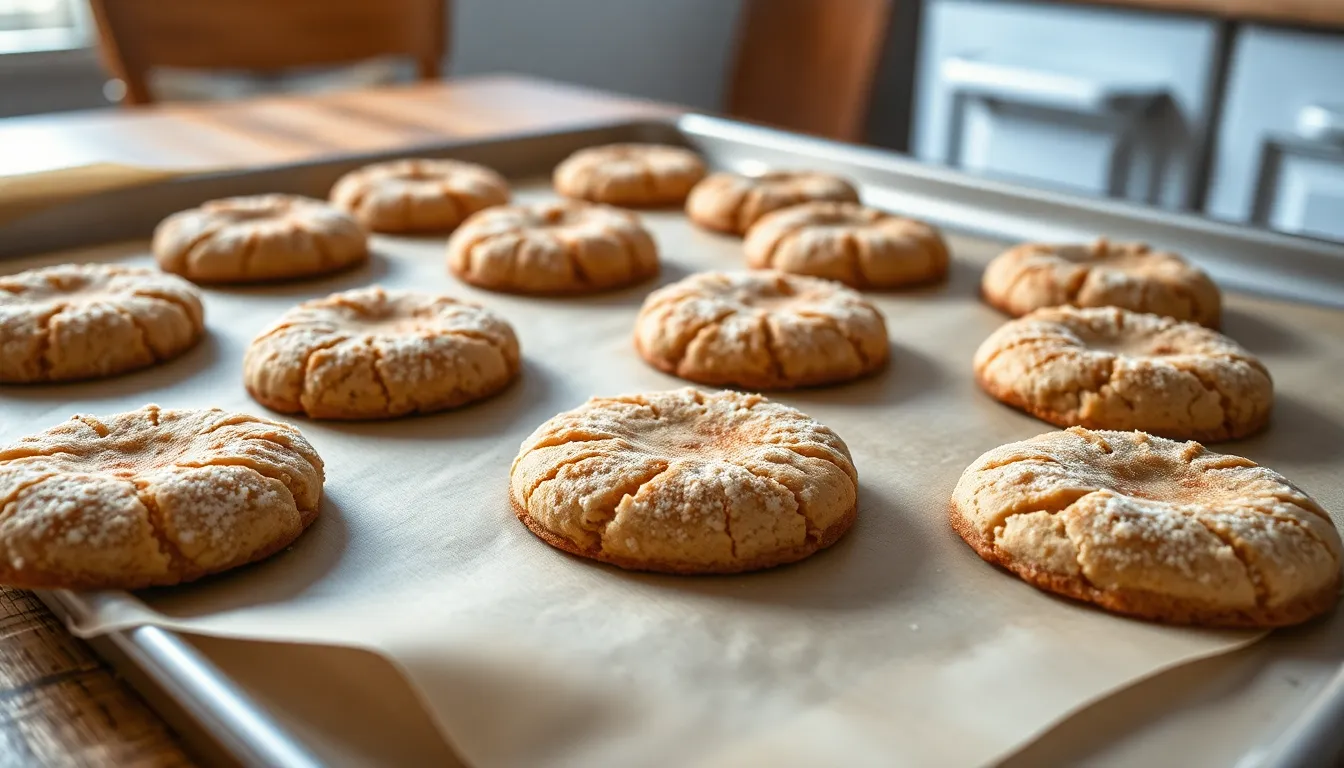
Follow these straightforward steps to create perfectly soft and chewy snickerdoodles that rival any traditional recipe. Our method ensures consistent results every time without the need for specialty ingredients.
Prep the Dough
Begin by preheating your oven to 375°F and lining a baking sheet with parchment paper. Combine ½ cup softened butter with ¾ cup granulated sugar in a large mixing bowl using a hand or stand mixer. Beat the mixture until light and fluffy, which typically takes 3-4 minutes on medium speed.
Add 1 large egg and 1 teaspoon vanilla extract to the creamed butter mixture. Mix until the ingredients are completely smooth and well incorporated. The mixture should appear pale and creamy at this stage.
Gradually incorporate the dry ingredients by first whisking together 1⅓ cups all-purpose flour, 1 teaspoon baking powder, and ¼ teaspoon salt in a separate bowl. Add the flour mixture to the wet ingredients in two additions, mixing on low speed until just combined. Avoid overmixing to maintain the tender texture we want in our finished cookies.
Shape and Coat the Cookies
Prepare the cinnamon sugar coating by combining 3 tablespoons granulated sugar with ½ tablespoon ground cinnamon in a shallow bowl. Mix thoroughly to ensure even distribution of the spice.
Using a 3-tablespoon cookie scoop or your hands, portion the dough into large balls approximately 1½ inches in diameter. Roll each dough ball completely in the cinnamon sugar mixture, ensuring full coverage for that signature snickerdoodle appearance.
Place the coated dough balls on your prepared baking sheet, spacing them 3 inches apart to allow for spreading during baking. The generous spacing prevents the cookies from merging together as they expand in the oven.
Bake the Cookies
Bake the cookies for 10-13 minutes, watching carefully for light golden brown edges while the centers remain soft and slightly underbaked in appearance. The cookies will continue cooking on the hot pan after removal from the oven.
Remove the baking sheet from the oven when the edges are set but the centers still look slightly soft. Allow the cookies to cool on the baking sheet for 5 minutes before transferring them to a wire cooling rack.
Store your finished snickerdoodles in an airtight container at room temperature for up to 3 days to maintain their chewy texture and fresh flavor.
Tips for Perfect Snickerdoodles Without Cream of Tartar
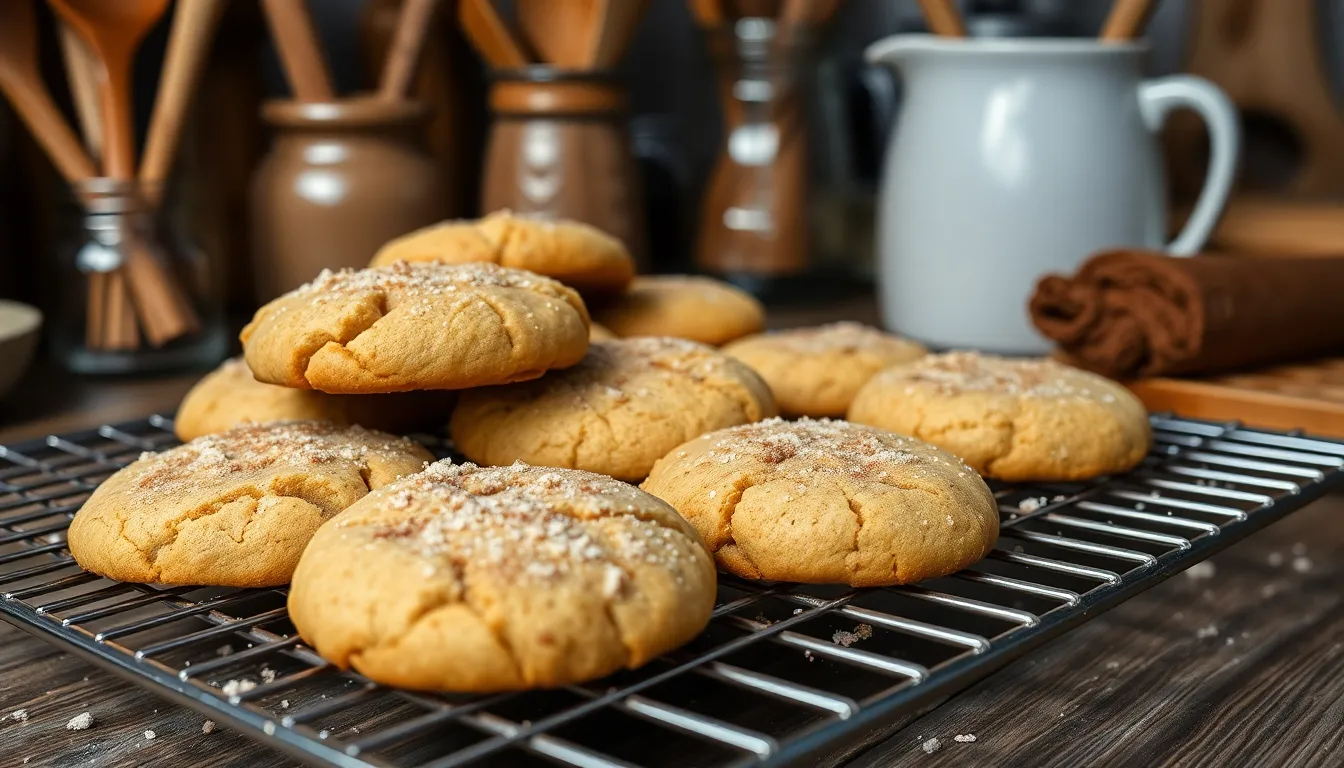
Monitor Baking Time Carefully
We recommend watching the cookies closely during the final minutes of baking. The edges should appear lightly set while the centers remain soft and slightly underbaked. This technique ensures our snickerdoodles maintain their signature chewy texture rather than becoming crispy.
Achieve the Right Butter Temperature
Softened butter creates the ideal cookie texture when properly prepared. We suggest leaving butter at room temperature for 30-60 minutes before baking. The butter should yield to gentle pressure but not be completely melted or too warm.
Roll Cookies Twice for Maximum Coating
Double rolling in cinnamon sugar intensifies the flavor and creates those beautiful crackled edges. We shape the dough balls first then roll them thoroughly in the cinnamon sugar mixture. After the initial coating we roll them again to ensure complete coverage.
Space Cookies Properly on Baking Sheets
Adequate spacing prevents cookies from spreading into each other during baking. We place cookie dough balls approximately 2 inches apart on our prepared baking sheets. This spacing allows for even heat circulation and proper spreading.
Use Fresh Ground Cinnamon
Fresh cinnamon provides the most aromatic and flavorful coating. We recommend checking the expiration date on ground cinnamon and replacing it if it lacks strong fragrance. Quality cinnamon makes a noticeable difference in the final cookie taste.
Don’t Overbake for Soft Centers
Perfect snickerdoodles require precise timing to maintain their tender centers. We remove cookies from the oven when edges are just beginning to turn light golden brown. The centers should still appear slightly soft and underdone at this stage.
Cool on Wire Racks Immediately
Proper cooling prevents cookies from becoming soggy on the bottom. We transfer baked snickerdoodles to wire cooling racks within 2-3 minutes of removing them from the oven. This technique allows air to circulate around the entire cookie surface.
Storage Instructions
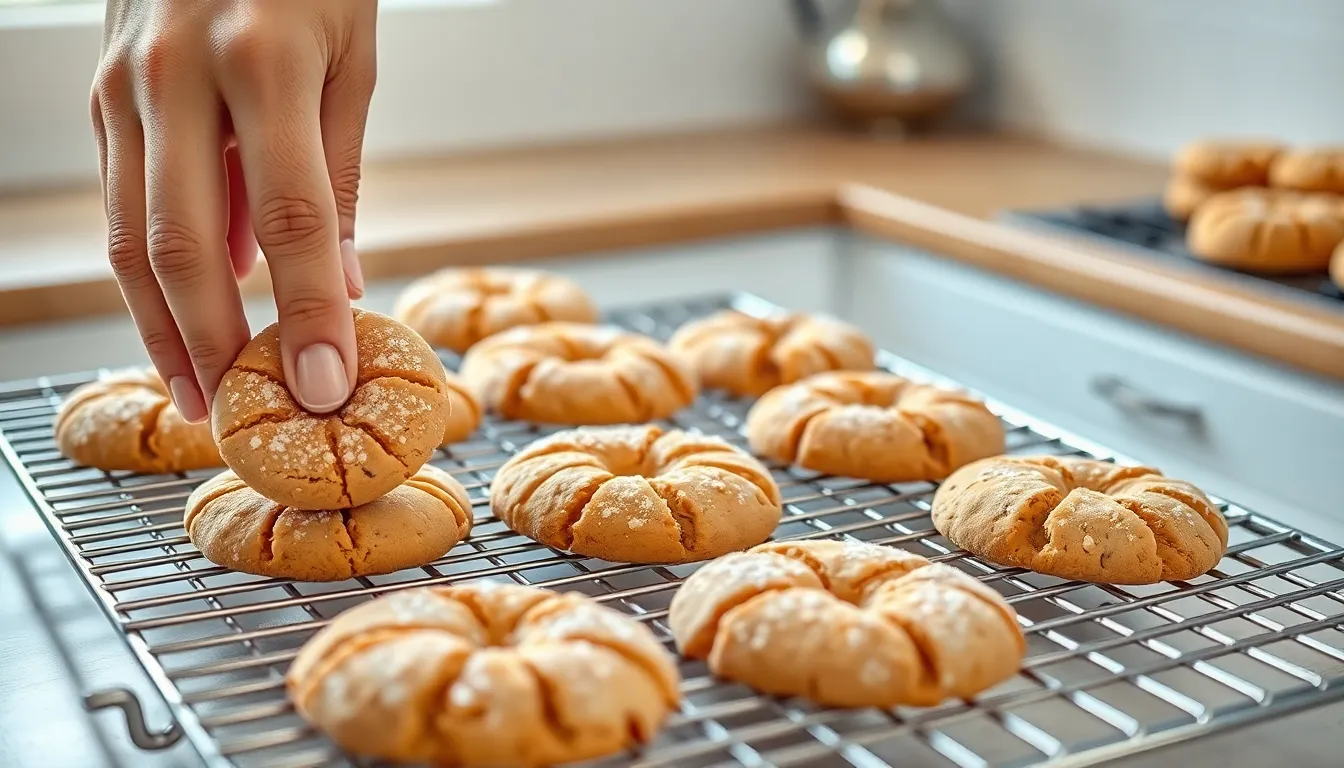
We know how important it is to keep your snickerdoodles without cream of tartar fresh and delicious for as long as possible. These cookies maintain their soft, chewy texture and retain their full flavor when stored properly using the right methods.
Room Temperature Storage
Store your finished snickerdoodles in an airtight container at room temperature for optimal freshness. The cookies will remain soft and flavorful for about 5 days when kept in a sealed container away from direct sunlight and heat sources.
Refrigeration Method
We recommend refrigerating your snickerdoodles for extended freshness beyond the 5-day room temperature limit. Place the cookies in an airtight container and store them in the refrigerator where they will maintain their quality for a longer period than room temperature storage.
Freezing Unbaked Dough
Prepare your cookie dough balls and arrange them on a parchment-lined baking sheet for freezing. Freeze the dough balls until they become firm, which typically takes about 30 minutes. Transfer the frozen dough balls to a zip-top freezer bag for long-term storage up to 3 months.
Bake the frozen dough balls directly from the freezer without thawing. Roll each frozen dough ball in the cinnamon sugar coating just before placing them on the baking sheet. Increase the baking time to approximately 14 minutes to ensure proper cooking from the frozen state.
Freezing Baked Cookies
Wrap each baked snickerdoodle individually in two layers of plastic wrap for maximum protection. Cover the wrapped cookies with aluminum foil to prevent freezer odors from affecting the taste. Store the wrapped cookies in a freezer bag or airtight container for up to 3-4 months.
Thaw frozen baked cookies overnight in the refrigerator before serving. Rewarm the thawed cookies briefly in a low oven to restore their fresh-baked texture and enhance their cinnamon sugar coating.
| Storage Method | Duration | Container Type | Special Instructions |
|---|---|---|---|
| Room Temperature | 5 days | Airtight container | Keep away from heat and sunlight |
| Refrigeration | Extended beyond 5 days | Airtight container | Store in refrigerator |
| Frozen Dough | Up to 3 months | Zip-top freezer bag | Bake directly from frozen |
| Frozen Baked Cookies | 3-4 months | Freezer bag/container | Thaw overnight, rewarm before serving |
Variations and Substitutions
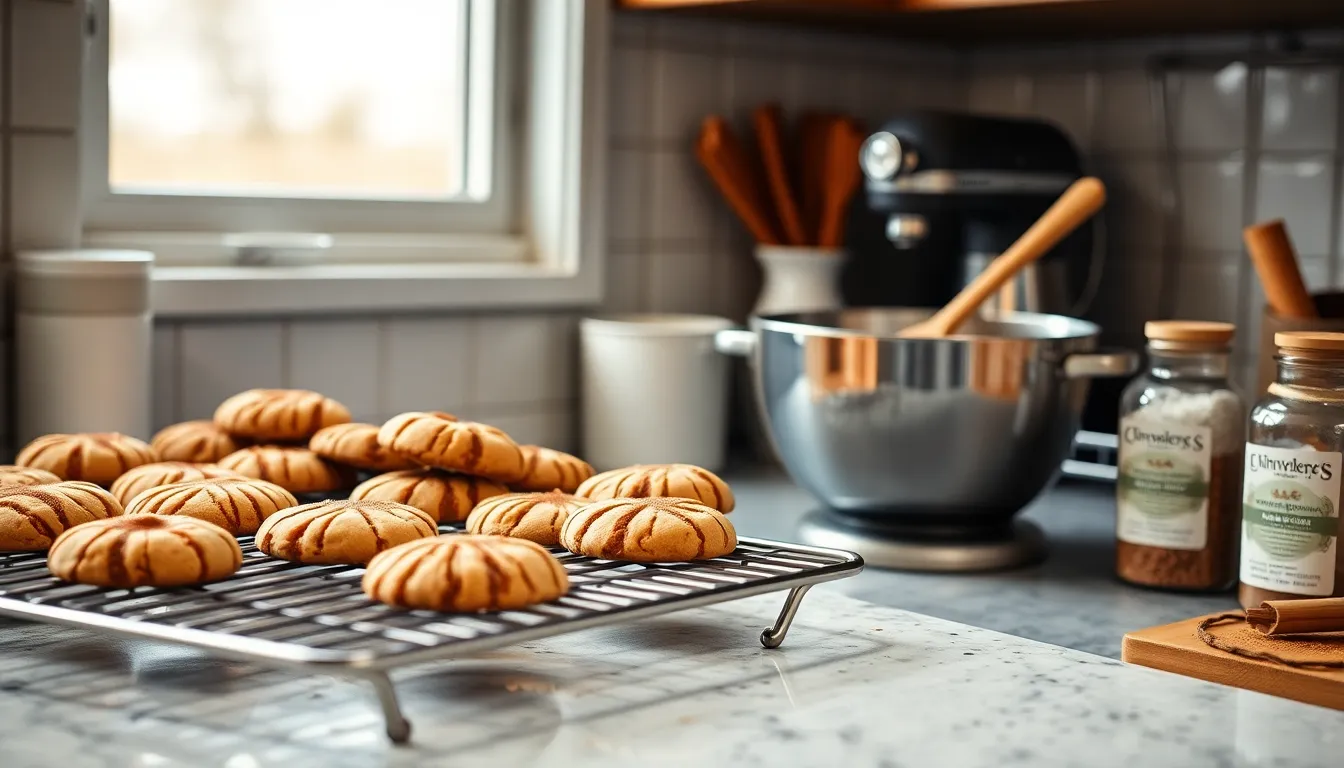
Our snickerdoodle recipe without cream of tartar opens the door to countless creative possibilities while maintaining the classic flavors you love. We’ve discovered that baking powder serves as the perfect leavening substitute, containing both acid and base components that effectively replace the traditional cream of tartar and baking soda combination.
Leavening Agent Alternatives
Baking powder becomes our go-to leavening agent when cream of tartar isn’t available. We use 2 teaspoons of baking powder to achieve the same lift and texture as traditional recipes. This substitution eliminates the need to hunt down cream of tartar while delivering equally soft and chewy results.
Flavor Variations
We love experimenting with different spice combinations in our cinnamon sugar coating. Try mixing 1/4 teaspoon of nutmeg or cardamom into your cinnamon sugar blend for warmth and complexity. Pumpkin pie spice creates an autumn-inspired twist, while a pinch of ginger adds subtle heat.
Brown sugar variations transform our cookies’ texture and taste. We substitute up to half of the granulated sugar with packed brown sugar for deeper molasses notes and extra chewiness. Light brown sugar provides gentle caramel undertones, while dark brown sugar creates more pronounced richness.
Butter Alternatives
Salted butter works beautifully in our recipe when you reduce the added salt by half. We’ve tested coconut oil as a dairy-free option, using it in solid form at room temperature for similar results to butter. Margarine substitutes cup for cup, though the flavor profile changes slightly.
Flour Modifications
All-purpose flour remains our preferred choice, but we’ve successfully used cake flour for more tender cookies by adding 2 tablespoons extra per cup. Whole wheat pastry flour creates heartier cookies with nutty undertones when substituted for up to half the all-purpose flour.
| Substitution Type | Traditional | Our Alternative | Result |
|---|---|---|---|
| Leavening | Cream of tartar + baking soda | Baking powder only | Same soft texture |
| Sugar | All granulated | Part brown sugar | Chewier texture |
| Flour | All-purpose only | Cake flour blend | More tender |
| Fat | Unsalted butter | Salted butter | Adjust salt accordingly |
Quick Preparation Methods
Our recipe requires no chilling time, allowing immediate baking satisfaction in under 30 minutes from start to finish. Room temperature ingredients blend more easily, creating smoother dough and more consistent cookies. We recommend softening butter naturally rather than microwaving for best texture results.
These adaptations ensure our snickerdoodles remain accessible regardless of pantry limitations while preserving the beloved characteristics that make these cookies special.
Troubleshooting Common Issues

Even with our foolproof recipe, certain challenges can arise when baking snickerdoodles without cream of tartar. We’ve identified the most common problems home bakers encounter and provide practical answers to ensure perfect results every time.
Flat or Overly Spread Cookies
Measuring flour incorrectly often causes cookies to spread too much during baking. We recommend spooning flour into measuring cups and leveling with a knife rather than scooping directly from the bag. Sifting flour before measuring creates even more accurate results and prevents dense, flat cookies. Room temperature butter that’s too warm can also cause excessive spreading, so we suggest testing butter firmness by pressing gently with your finger—it should give slightly but hold its shape.
Puffy or Cake-Like Texture
Overpacking flour into measuring cups creates cookies that rise too much and lose their characteristic chewy texture. We always measure flour by the spoon-and-level method to maintain the proper flour-to-fat ratio. Overmixing the dough after adding flour develops too much gluten, resulting in tough, puffy cookies instead of tender ones.
Uneven Baking Results
Inconsistent cookie sizes lead to uneven baking where smaller cookies overbake while larger ones remain underdone. We use a cookie scoop to portion dough uniformly, ensuring all cookies bake at the same rate. Rotating the baking sheet halfway through the baking time helps achieve even browning, especially if your oven has hot spots.
Loss of Cinnamon Sugar Coating
Rolling cookies in cinnamon sugar when the dough is too cold prevents proper coating adhesion. We shape dough balls and let them sit at room temperature for 2-3 minutes before rolling in the coating mixture. Double rolling—once before and once after the brief rest—ensures maximum coating coverage and prevents the spice mixture from falling off during baking.
Cookies Too Hard or Crispy
Overbaking transforms soft, chewy snickerdoodles into hard, crispy cookies that lack the desired texture. We remove cookies from the oven when edges are light golden brown but centers still appear slightly underbaked—they continue cooking on the hot baking sheet. Using a timer and checking cookies at the 10-minute mark prevents accidental overbaking.
Conclusion
We’ve shown you that incredible snickerdoodles don’t require cream of tartar to achieve that perfect chewy texture and signature tangy flavor. Our simplified approach using common pantry ingredients makes these beloved cookies accessible to everyone.
The beauty of this recipe lies in its flexibility and foolproof nature. Whether you’re experimenting with different spice blends or adjusting sugar ratios to suit your taste preferences these snickerdoodles deliver consistent results every time.
We’re confident that once you try this streamlined method you’ll never miss the cream of tartar. Your kitchen will smell amazing and your cookie jar will stay full of these irresistible cinnamon-sugar treats that everyone loves.
Frequently Asked Questions
Can I make snickerdoodles without cream of tartar?
Yes! This recipe eliminates cream of tartar entirely while maintaining the classic tangy flavor and tender texture. The recipe uses baking powder as the primary leavening agent, along with a precise combination of granulated and brown sugar to achieve the signature soft and chewy consistency that makes snickerdoodles so beloved.
What ingredients do I need for cream of tartar-free snickerdoodles?
You’ll need basic pantry staples: all-purpose flour, baking powder, salt, softened unsalted butter, granulated sugar, one egg, vanilla extract, and optionally brown sugar for extra chewiness. The cinnamon sugar coating requires granulated sugar and ground cinnamon. No specialty ingredients or hard-to-find items are necessary.
How long do I bake these snickerdoodles?
Bake the cookies at 375°F for 10-13 minutes until the edges are light golden brown while centers remain soft. Monitor closely to avoid overbaking, which can make them hard and crispy instead of the desired chewy texture. The cookies will continue cooking slightly on the hot baking sheet after removal.
How should I store homemade snickerdoodles?
Store snickerdoodles in an airtight container at room temperature for up to 5 days to maintain their soft, chewy texture. For longer storage, refrigerate in an airtight container or freeze baked cookies for 3-4 months. Unbaked dough can be frozen for up to 3 months and baked directly from frozen.
Why are my snickerdoodles flat or spreading too much?
Flat cookies usually result from butter that’s too warm, overmixing the dough, or incorrect measurements. Ensure butter is softened but not melted, measure flour accurately using the spoon-and-level method, and avoid overworking the dough. Chilling the dough for 15-30 minutes can also help prevent excessive spreading.
Do I need special equipment to make these cookies?
No special equipment required! You only need basic kitchen tools: a large mixing bowl, hand or stand mixer, measuring cups and spoons, a baking sheet with parchment paper, and a wire cooling rack. A cookie scoop helps create uniform sizes but isn’t essential for success.
How do I get the cinnamon sugar to stick properly?
Roll the cookie dough balls twice in the cinnamon sugar mixture for maximum coating coverage. The first roll creates an initial layer, while the second ensures complete coverage and prevents the coating from falling off during baking. Use fresh ground cinnamon for the best flavor and adherence.
Can I make variations to this basic recipe?
Absolutely! Try adding nutmeg or cardamom to the cinnamon sugar coating, substitute cake flour for extra tenderness, or use whole wheat pastry flour for a heartier texture. You can also experiment with different sugar ratios or add a pinch of sea salt on top before baking for enhanced flavor complexity.

